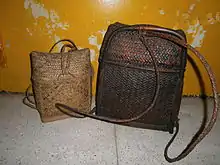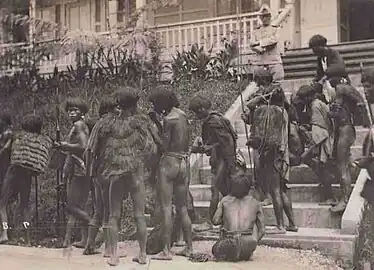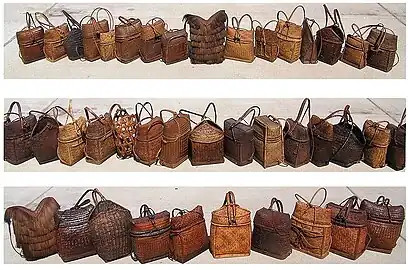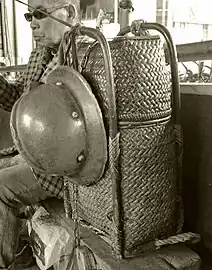Pasiking
The pasiking (English term: knapbasket[1]) is the indigenous basket-backpack found among the various ethno-linguistic groups of Northern Luzon in the Philippines. Pasiking designs have sacred allusions, although most are purely aesthetic. These artifacts, whether handwoven traditionally or with contemporary variations, are considered exemplars of functional basketry in the Philippines and among Filipinos.[2]

The sacred, ritual pasiking of the Ifugao tribal group is called the inabnutan, not to be confused with the more common bangeo.[3] Both of those types have abnut palm bast and/or apangdan vine weatherproofing. The bangaw has a rigid, fixed flap over the shoulders, while the inabnutan has a flexible woven flap. [4][5]

Another sacred, ritual pasiking of the Highland Philippine Bontoc and Kankanaey peoples is called the takba. Representing an ancestor figure, the takba is an active participant in begnas rituals.[6] These takba must be fed or its contents recharged periodically. To neglect or disrespect a takba is to risk punishment of becoming "bagtit" or demented.
Some of the Northern Philippine tribal groups called Igorots or Cordillerans[7] that weave pasiking are the Apayaos or Isneg, the Tinguian of Abra province, the Kalingas of Kalinga province, the Gaddang, the Bugkalot, the Applai, the Bontocs of Bontoc, Mountain Province, the Ilagod, the Bago, the Kankana-ey, the Balangao, the Ibaloi, the Ifugaos, the Ikalahan, the Kalanguya, the Karao, and the Ilongots. It is also woven using rattan by non-Cordilleran persons.[8]
The most common materials used in construction are rattan and bamboo. There are also pasiking specimens utilizing deer hide (parfleche), wood, whole turtle shell, and at least one documented sample in crocodile skin.
A deconstructed version of the pasiking, including dozens of antique, vintage and contemporary variants, were exhibited in the BenCab Museum.[9] There are also 21st century pasiking that are made of recyclable materials like plastic cargo straps, canvas conveyor belts, and recycled detonation cord.[10]
An exhibit at Museo Kordilyera at University of the Philippines Baguio from December to January 2022 showcased several varieties of these traditional backpacks.[11]
In the 1970s on through the 1980s, the pasiking has also been a symbol among Filipino students for nationalist activism. There was a decline of making traditional bamboo crafts, including the pasiking, during the 1980s but in the mid-2010s, the industry of bamboo crafts came into resurgence with the help of the Philippines' Department of Trade and Industry.[12]
.jpg.webp) Pasiking in various styles
Pasiking in various styles Ifugao pasiking during the early American period in Camp John Hay, Baguio City
Ifugao pasiking during the early American period in Camp John Hay, Baguio City Contemporary 21st-century pasiking using recycled plastic polypropylene cargo straps
Contemporary 21st-century pasiking using recycled plastic polypropylene cargo straps Pasiking specimens; photographed in Pt. Richmond, CA, in 2004
Pasiking specimens; photographed in Pt. Richmond, CA, in 2004 Ifugao hape'eng backpack
Ifugao hape'eng backpack
References
- "Pasiking". University of the Philippines Diliman Department of Anthropology. Retrieved 28 October 2015.
- The NCI SF homepage on pasiking.com
- Tiw-Tiwong: An Uncyclopedia to Life, Living, and Art in Baguio, the Cordilleras, and Beyond: Baguio Kunst Book Publishing and Partners for Indigenous Knowledge Philippines, 2022 ISBN: 978-621-96739-0-7
- Natido Binwag weaves the bango, Council for Living Traditions • 1978 • By: Ng, Mary.
- Eloquent Simplicity: In Wood and Fiber. Quintos, Floy; Cating, Armand Voltaire; YUCHENGCO MUSEUM (Makati, Philippines)., 2012
- https://thecordillerareview.upb.edu.ph/abstract/roland-erwin-p-rabang/
- Blog on the Igorots, plus a photo of an Igorot pasiking
- Gascon, Melvin (27 May 2015). "Blind weaver's masterpiece a tribute to Ifugao heritage". Philippine Daily Inquirer. Philippines. Retrieved 28 October 2015.
- "Gallery News: 'Carrier of Tradition: An Exhibition of Northern Philippine Backpacks' at BenCab Museum". The Philippine Star. Philippines. 15 December 2014. Retrieved 28 October 2015.
- Lolarga, Elizabeth (21 May 2012). "Cool everyday objects bridge old, new in the Cordillera". Philippine Daily Inquirer. Philippines. Retrieved 28 October 2015.
- Pasiking: Native Backpacks of Luzon Dec 2022 https://museokordilyera.upb.edu.ph/exhibitions/pasiking-native-backpacks-of-luzon-cordillera/
- Beleo, Erwin (26 November 2014). "Resurgent bamboo craft industry in far-flung village". Manila Bulletin. Philippines. Retrieved 28 October 2015.